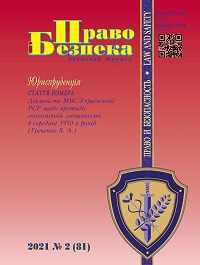Problems of Vehicle Identification by Tire Marks on the Soil
DOI:
https://doi.org/10.32631/pb.2021.2.14Keywords:
vehicle, tire marks, identification, traceological examination.Abstract
Scientific research is focused on the problems of vehicle identification by tire marks on the soil. It is argued that the car can either be a participant in a traffic accident or be used during theft of property or kidnapping.
The constructional features of the wheels and tires of a car, which are important in the formation of tracks, are described. When the wheel comes into contact with the soil, the tread pattern is reflected.
The features of the vehicle tire marks recorded by the investigator and the forensic scientist during the scene search have been determined. Photo or video recording of car wheel tracks is possible, as well as preparing the impression from the display of the tread on the soil.
The possibilities of transport and traceological examination for studying the traces of car wheels have been established. The procedure for appointing an expert examination by an investigator is described. There is a list of materials that are provided for an expert study, as well as a list of questions that can be posed to an expert.
It is argued that a problem in proving the involvement of a vehicle in the commission of a crime is the possibility of the vehicle tires or wheels to be replaced immediately after it has been committed. Recommendations regarding the identification of a vehicle based on tire marks on the soil are suggested. To establish the fact of changing tires on a car after the commission of a crime, the investigator must seize all sets of tires that are found in the suspect’s household or garage. It is possible to confirm the fact of changing tires on a particular car by interrogating employees of service stations located near the suspect’s residence. In addition to tire marks, to identify the vehicle, it is worth using the testimony of witnesses regarding the model and color of the car, traces of glass debris and paint chips at the accident site and damage on the car itself.
Downloads
References
Sezonov V.S., 2019. The essence and significance of a comprehensive forensic examination of vehicles [Sutnіst і znachennia kompleksnoho ekspertno-krimіnalіstychnoho doslіdzhennia transportnykh zasobіv]. Pìdpriêmnictvo, gospodarstvo ì pravo – Entrepreneurship, Economy and Law, No. 5, pp. 313-317.
Kyrychenko S.A., 2007. Concepts, properties and classification of evidence in criminal proceedings [Poniattia, vlastyvostі і klasyfіkatsіia dokazіv u krimіnalnomu sudochynstvі]. Pìvdennoukraïnsʹkij pravničij časopis – South Ukrainian Law Journal, No. 4, pp. 119-121.
Klymchuk M.P., 2005. Checking the information about the accident in case of disappearance of the driver from the scene [Perevіrka іnformatsіi pro dorozhno-transportnu pryhodu pry znyknennі vodіia z mіstsia pryhody]. Naukovyi vіsnyk Ukrainskoi akademіi vnutrіshnіkh sprav, No. 3, pp. 272-277.
Moroz І.V., 2017. Tactics of actions of police officers during registration of appendices to the report of inspection of a place of road accident [Taktyka dіi pratsіvnykіv polіtsіi pіd chas oformlennia dodatkіv do protokolu ohliadu mіstsia dorozhno-transportnoi pryhody]. Pìdpriêmnictvo, gospodarstvo ì pravo – Entrepreneurship, Economy and Law, No. 3, pp. 286-289.
Diachuk V.І., 2010. The use of automotive knowledge in the conduct of investigative actions. [Vykorystannia avtotekhnіchnykh znan pry provadzhennі slіdchykh dіi]. Vіsnyk Volynskoho natsіonalnoho unіversytetu іmenі Lesі Ukrainky. Serіia yurydychna, No. 3, pp. 588-592.
Skіlska L.D., 2009. Tactical and technical features of using video in the process of inspecting the scene [Taktyko-tekhnіchnі osoblyvostі vykorystannia vіdeozapysu u protsesі ohliadu mіstsia podіi]. Deržava ì pravo – State and Law, Iss. 39, pp. 574-578.



